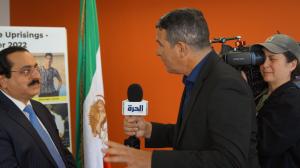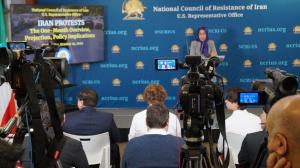Iran Protests: the One-Month Overview, Projection, Policy Implications
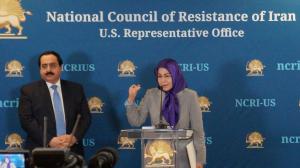
Ms. Soona Samsami, the U.S. Representative of the NCRI, discussing Iran uprising and the prospects for the overthrow of the regime during a press briefing at the Washington office of the NCRI on Oct 19, 2022. Alireza Jafarzadeh is standing next to her.
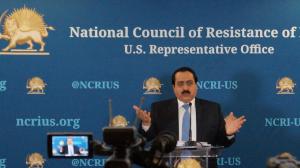
Mr. Alireza Jafarzadeh, the dep. dir. of the NCRI-US during a press briefing at the Washington office of the NCRI on Oct 19, 2022, presenting information about the full engagement of the IRGC in the suppression of the uprising in Tehran and elsewhere.
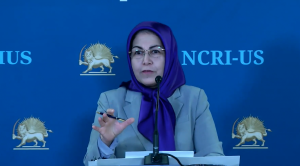
Ms. Soona Samsami, the U.S. Representative of the NCRI, discussing Iran uprising and the prospects for the overthrow of the regime during a press briefing at the Washington office of the NCRI on Oct 19, 2022.
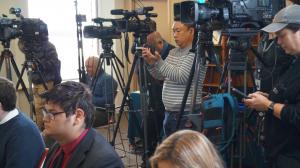
Media attending the conference on Iran uprising and the prospects for the overthrow of the regime during a press briefing at the Washington office of the NCRI on Oct 19, 2022.
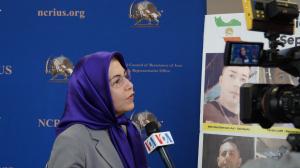
Ms. Soona Samsami, the U.S. Representative of the NCRI, being interviewed by media at a briefing on Oct 19, 2022 at NCRI office in Washington, discussing Iran uprising and prospects for changing the regime. Dozens of reporters attended the conference.
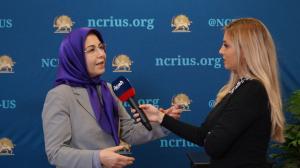
Ms. Soona Samsami, the U.S. Representative of the NCRI, being interviewed by media at a briefing on Oct 19, 2022 at NCRI office in Washington, discussing Iran uprising and prospects for changing the regime. Dozens of reporters attended the conference.
A Revolution in the Making: As anti-regime protests in Iran enter their second month, NCRI discusses the details behind this historical event.
WASHINGTON, DISTRICT OF COLUMBIA, USA, October 21, 2022 /EINPresswire.com/ -- As anti-regime Iran protests in Iran enter their second month, the opposition National Council of Resistance of Iran – US Representative Office (NCRI-US), held a press briefing at its Washington office on Wednesday, October 19, 2022, to provide a detailed status report and the latest information provided by the Resistance’s network inside Iran.
Ms. Soona Samsami, the U.S. Representative of the NCRI, discussed the depth and extent of the uprising, its focus, its organizational and leadership aspects, the prospects for the overthrow of the regime and policy implications for the international community.
Mr. Alireza Jafarzadeh, the deputy director of the NCRI-US presented the information obtained from inside Iran about the full engagement of the Islamic Revolutionary Guard Corps (IRGC) in the suppression of the uprising both in the capital Tehran as well as all over the country. He also provided details about the bloody assault on the Evin Prison and its fallout. Samsami and Jafarzadeh responded to questions posed by the journalists who had joined both in person and online.
Available below are the full remarks by Ms. Samsami followed by remarks by Mr. Jafarzadeh.
REMARKS BY MS. SOONA SAMSAMI, U.S. REPRESENTATIVE, NATIONAL COUNCIL OF RESISTANCE OF IRAN:
Starting on September 16, 2022, a new wave of anti-regime protests broke out in Iran which has now entered its second month.
The protests rapidly morphed into a universal call for regime downfall and democratic revolution.
The persistence of the uprising has now far outlasted all previous uprisings since 2017.
Some 194 cities in all 31 provinces, various sectors of the Iranian society, including many key universities, four generations, even high schools have joined the uprising.
The uprising is singularly focused on the Supreme leader Ali Khamenei, rejecting any form of dictatorship. This is evident in the chants of “Death to Dictator,” “Death to Khamenei,” and “Death to the Oppressor, be it the Shah or the Leader (referring to Khamenei).”
The protesters are determined and laser focused only on one objective: the overthrow of the clerical regime in its entirety.
The regime has so far killed over 400. We have identified 241 of those fallen for freedom among them at least 28 underage teenagers, including the 12 year old Mohammad Rakhshani who was killed in Zahedan.
Well over 20,000 have been arrested.
Yet all the killings, arrests and torture have only added fuel to the fire.
The protesters, led by women, are quite agile and use different tactics to evade arrest and charge at the security forces.
Regime has admitted to at least 2,000 of its agents being beaten and wounded in acts of self-defense by the protesters.
In fact, what is happening in Iran today has all the hallmarks of a revolution in the making.
We have passed a historic inflection point with people’s fear dissipating and fear reigning in the regime, a point of no return.
No matter what the regime does and despite all the ebbs and flows, the regime can never return to the status que. This is evident in one remarkable chant: “For everyone that is killed, a thousand rise in his/her place.”
The protests, though sparked by the tragic murder of 22-year-old Mahsa Amini, are increasingly organized and have sharp direction and are on message, leaving little room for Tehran’s plots to derail it.
These protests are neither leaderless, nor sporadic.
The Iranian nation is increasingly unified behind chants of “Death to Khamenei” and “Death to Dictator.” Those leading the fight on the ground to confront the repressive forces are setting the pace and leading the way in the streets. This is a very forward looking nationwide democratic revolution and the objective is clearly chanted in the Iranian street, “Freedom, Freedom, Freedom.”
ROLE OF WOMEN:
Let me say a few words about the role of women during the uprising.
The world has been witnessing the courage, bravery, commitment, and enormous wisdom among the Iranian women confronting a regime that considers them as second-class citizens.
The women resilience did not emerge overnight. Over 35 years of women leadership in the organized Resistance against the regime has created a culture of defiance among the women who are not fighting only for their own rights, rather their priority is to free their nation.
How has that happened?
Our movement, was in the forefront of defending women who chose not to wear hijab during the major demonstration in Tehran in March 1979 against mandatory hijab.
During the 1988 massacre of some 30,000 political prisoners in Iran, there were thousands of women who chose to say NO to the ayatollahs. It is this history of 40 plus years of women fighting against the regime and paying the ultimate price that is now manifested in the schoolgirls, and female university students all across Iran taking to the streets and leading the charge to topple this regime.
Some twenty-six years ago, in June 1996, the President-elect of the National Council of Resistance of Iran, Mrs. Maryam Rajavi, during a major speech in London titled “women force for change,” before tens of thousands of people addressed the ruling Ayatollahs and said, “You have used all possible forms of humiliation, oppression, repression, torture, and murder against Iranian women. But I assure you that your oppressive rule will be swept away by Iran’s conscious and free women…Today’s oppressed women are the victors of tomorrow.”
PROSPECTS FOR CHANGE:
The fact that we are talking about continued protests five weeks after it was triggered, is significant. What has contributed to this is twofold.
First, the divide between the people and the regime has gotten far deeper than ever before, as those who used to be on the sidelines, have now gotten involved. The intensity and anger among the people against the regime has never been so high.
Second, the role of organized resistance particularly the resistance units of the Mujahedin-e Khalq, or the MEK has been critical. Over the past five years, these Resistance Units, consisting mostly of youth with significant participation of women, have played a significant role in trying to crack the wall of repression by torching the posters, statues of regime’s officials such as Khamenei, and Qassem Soleimani, and targeting centers belonging to the IRGC and the Basij, mounting cyber operations to take over the radio and television of the regime, disclosing information about the prisons organization and other acts of defiance, laying bear the vulnerabilities of the regime and the power of the people.
This summer during the annual summit of the Resistance, over 5,000 members of the Resistance Units of the MEK sent video-taped messages in support of the Resistance and in favor of changing the regime, a 500 percent increase relative to the year before.
ROLE OF INTERNATIONAL COMMUNITY:
At the end, let me make a few policy recommendations:
First, lead in concert with democratic allies at the United Nations punitive political, diplomatic, and commercial sanctions against the Iranian regime. All its embassies must be shut down and its diplomats expelled. Tehran must be treated as it deserves, a pariah state and thus it should be expelled from all international bodies and all economic ties must be severed.
Second, the United States and the European Union should support the Iranian people’s bid for democratic revolution against their tyrannical rulers. They need to recognize the Iranian people’s right to self-defense against the brutal attacks of the regime in accordance with the Universal Declaration of Human Rights that recognizes the right “to have recourse as a last resort, to rebellion against tyranny and oppression.”
Third, launch diplomatic efforts to establish an urgent special session of the United Nation’s Human Rights Commission as well as other urgent measures to secure the freedom of political prisoners, prevention of torture and execution.
Fourth, refer the dossier of four decades of genocide and crimes against humanity including the 1988 massacre of 30,000 political prisoners, as well as those in November 2019 and current killings during the uprisings including the October 2022 murder at Evin Prison, and bring the leaders of the Iranian regime including Khamenei and Raisi to justice.
Thank you very much.
________________
REMARKS BY ALIREZA JAFARZADEH, DEPUTY DIRECTOR, WASHINGTON OFFICE, NATIONAL COUNCIL OF RESISTANCE OF IRAN:
Since the uprising started in mid-September 2022, the main questions were for how long this could go on, if the Islamic Revolutionary Guard Corps (IRGC) would directly get involved, and how effectively the regime can stop it as quickly as possible.
This is day 34 of Iran protests and they are still going on with even more intensity and resolve and the regime has not been able to stop them up to this point.
According the internal reports from withing the IRGC, from the very early days of the start of the uprising, the IRGC has been engaged with full force and has mobilized its full capacity.
ROLE OF SARALLAH GARRISON:
At this moment, it is the Sarallah Garrison that is in charge of all the suppressive forces in Tehran Province. The IRGC commander-in-chief, Hossein Salami is the commander of Sarallah Garrison and thus leading all the suppressive forces across Iran to put down the uprisings.
According to internal protocols, when the security situation is in red alerts, such as the current circumstances, it is the IRGC that takes control of all apparatus of repression in all 31 provinces of Iran, under the supervision of the Supreme National Security Council. Other suppressive bodies, such as the State Security Forces (NAJA), come under their command.
Reports suggest that over the past month, the IRGC has used its forces, either as plainclothes forces, some wear State Security Forces gears, and others are deployed near potential trouble spots to be used when called upon.
MAXIMUM BRUTALITY AND VISCOUSNESS:
According to hundreds of reports we have received, the plainclothes forces of the IRGC and the Basij use maximum brutality and viscousness to beat the protesters and severely injure them. One of the tactics they use is to beat the protesters in the head or break their limbs; this would in effect end their continued participation in the protests for a period.
Murdering the Evin prisoners is one recent example of the tactics used by the regime.
CRIME AGAINST HUMANITY AT EVIN PRISON:
Evin is the most notorious prison in Iran, built in 1972 by the deposed Shah who used it for holding political prisoners, among them many leaders of the MEK movement. Evin became a symbol of savagery on the one hand and a symbol of resistance by those seeking freedom on the other.
On October 15, 2022, thirty to forty prisoners were killed during an attack on Evin Prison, by the IRGC Special Force guarding the Supreme Leader (NOPO). The attack on the prisoners was planned in advance. The savage guards (NOPO) threw some prisoners down from the roof. They targeted the prisoners in the courtyard with live ammunition from the roof.
NOPO attacked Ward 8, where political prisoners are kept with live ammunition and shotguns, and fired tear gas to the point of suffocation. After shooting and firing tear gas, the special unit forces made the prisoners lie down in the prison yard and beat them to the point of death. They extensively used stun guns to beat the prisoners.
They transferred 51 prisoners from Ward 8; a prisoner with five bullets in his body was also taken in the same condition. Some of the prisoners were taken to Gohardasht prison, but the whereabouts of others are unknown. They fired tear gas inside the women’s Ward and locked the doors of the Ward so those female prisoners could not react to save themselves.
HEAVY HAND:
The IRGC has used helicopters (like in Tabriz) against the protesters, or has brought in tanks to protect the sensitive locations, such as the Radio and Television, as in Tehran and Shiraz.
Recalling the veteran IRGC commanders or using proxies.
The regime has employed its foreign proxies in various cities to suppress the uprising.
OVER THE TOP:
Because the uprising since mid-September soon became nationwide, the issue was soon handled by the Supreme National Security Council of the regime and Supreme Leader Ali Khamenei was heavily involved himself.
At times, when the regime was unable to contain the protests, it resorted to large scale killings such as Zahedan (Sistan & Baluchistan Province), and Sanandaj (Iranian Kurdistan). The regime has used bird shots, live fire, tear gas, and severe beatings to kill the protesters.
Another tactic has been widespread arrests to target the leaders of the protests, and making it difficult for reorganization of the protests. By torturing key elements, Tehran plans to get forced confessions, and bring them on TV. Campaign of lies and deception has been another tactic used by the IRGC.
IRGC’S FAILURE:
Despite all these measures over the past five weeks, the IRGC has failed to contain the uprising. This has had a ripple effect with the suppressive forces, who are suffering from very low morale and afraid of people’s wrath who could potentially punish there IRGC forces.
LOWER RANK DEFECTIONS:
According to reports which we have received from the repressive forces, only a limited number of Basij forces are willing to participate in suppressing the protests. The Basij is now resorting to underaged recruits with little effect. Also, the Basij commanders have been given instructions not to use demoralized forces or those who are shaky in defending the regime, a clear indication that they may soon run out of enough forces to contain the protests. Tehran has even threatened the IRGC and NAJA forces with court martial if they resign from service or refrain from following orders.
OVERPOWERED BY THE RESISTANCE AND THE PEOPLE:
The fact that the protests are nationwide and involves all sectors of the Iranian society, has made it very difficult for the suppressive forces to simultaneously confront them.
The other tactic used by the organized resistance is to have local protests in each district or neighborhood, to disperse the suppressive forces. According to the regime’s military commanders, some 108 locations in Tehran has witnessed protests.
The anger by the people is an all-time high and rising, something they had never seen before, a clear indication that the protests are not going to end until the regime is overthrown.
The slogans are also singularly focused on the Supreme Leader Ali Khamenei.
CONCLUSION:
Despite bringing all the suppressive forces of the IRGC, killing and beating the protesters, and showing savagery, and despite the crimes committed during the killings in Evin prison, the regime has been unable to contain the uprising in its fifth week, which has already gone far longer than all the previous uprisings.
Alireza Jafarzadeh
NCRI-US
+1 202-747-7847
email us here
Visit us on social media:
Facebook
Twitter
Iran: A Revolution in the Making
Legal Disclaimer:
EIN Presswire provides this news content "as is" without warranty of any kind. We do not accept any responsibility or liability for the accuracy, content, images, videos, licenses, completeness, legality, or reliability of the information contained in this article. If you have any complaints or copyright issues related to this article, kindly contact the author above.

